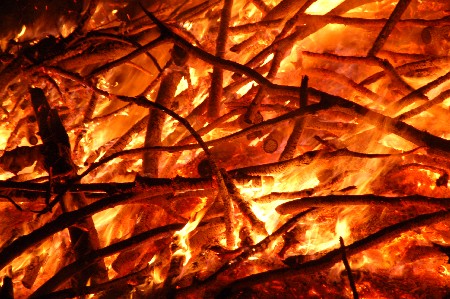On Sunday Invocavit, the 1st Sunday of fasting, our region as well as some parts of Austria and Switzerland celebrate a tradition called „Funkenfeuer“ (maybe best translated as „fire of flying sparks“). The days before youngsters collect old christmas trees, wood, straw, and crates within the local area. Now- adays associations dedicated to the maintenance of tradition are involved, too. Normally the collected material is piled up in an elevated spot within the village borders, in the midst of the stack a long branchless pole with a witch made of straw on top.
The evening of Sunday Invocavit kids and juveniles with lanterns and torches as well as adults assemble at the stake. Along with polka sounds of the local brass band the fire is lit up. The sparks are flying. Wine is served. Cheers are made. The highlight is reached when the witch is in flames and finally brought down.
Supposedly the „Funkenfeuer“ with its accompanied customs has a long tra- dition. Testimonies reach back to the 11th century in Germany, the Sunday Invocavit is dated back to the 13th century in France and there are various notes on Switzerland and the region along the shores of Lake Constance. From the 19th and 20th century there are many reports because of an inten- sification of field research within the developing ethnic, folklore, and cultural studies.
Nevertheless the definite origins and motives of the „Funkenfeuer“ are still a mystery. Theories range from power of nature motives, love and friendship rituals, fire victims and witchcraft, feast and fasting periods, to carneval and spring fire traditions. Originally, Sunday Invocavit was the final night of Fasching (carneval) for a long time. Today the main reason is to symbolically expel the wintertime …
Literature:
Kapfhammer, Günther, 1977: Brauchtum in den Alpenländern. München: Callwey.
Photos:
See the Funkenfeuer within the new gallery section (in process) …

